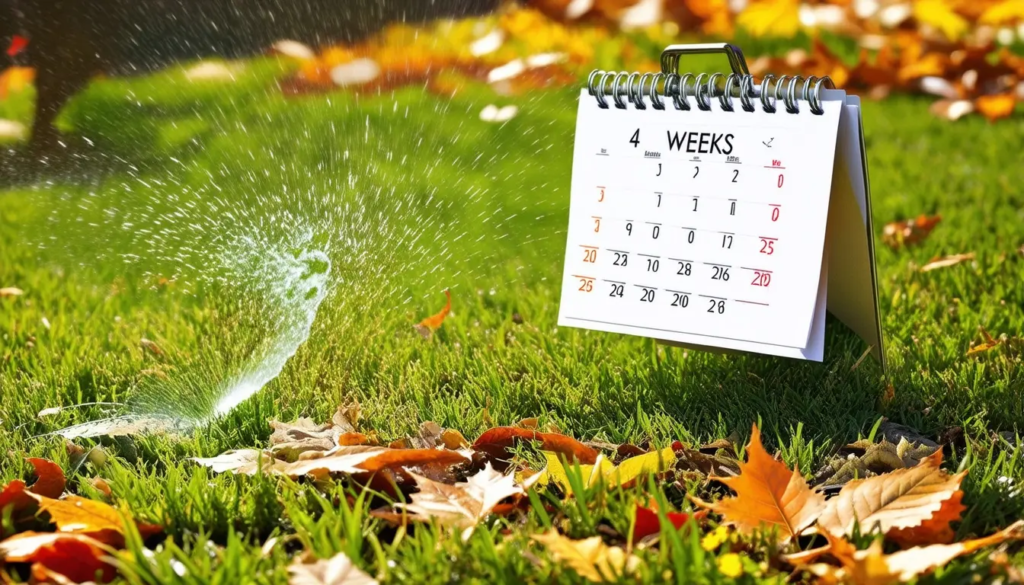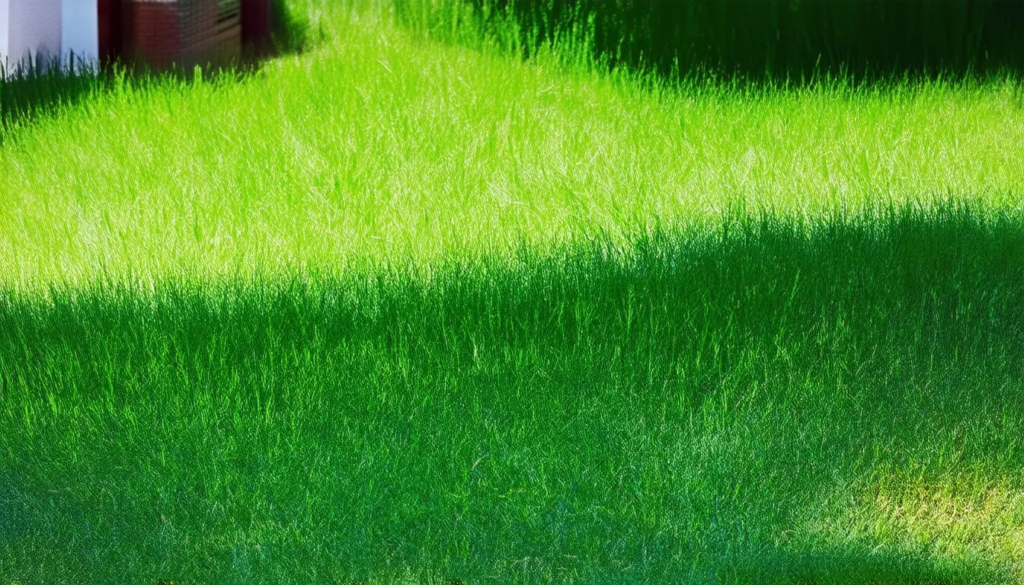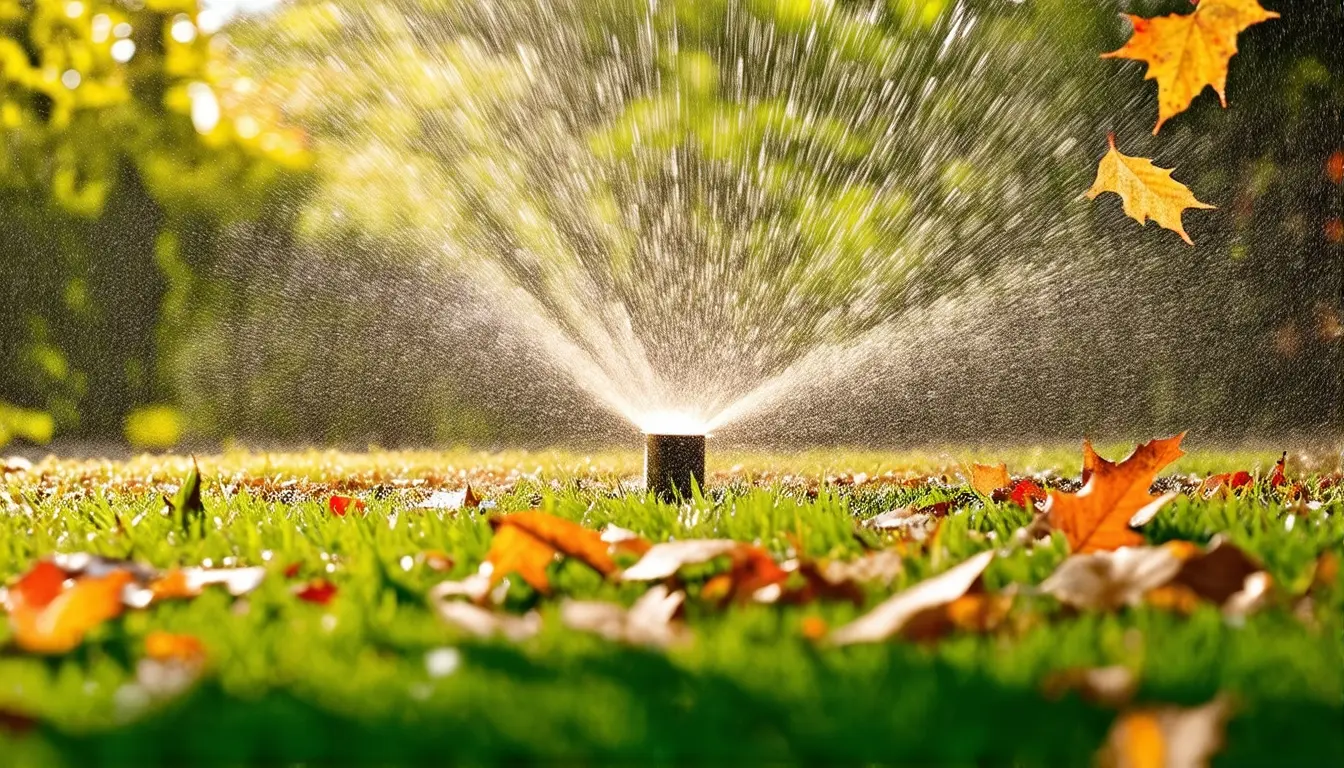With the arrival of autumn’s crisp air and vibrant foliage, Calgary’s homeowners are reminded that it’s time to focus on nurturing their lawns for the season. Proper hydration is a cornerstone of lawn care during this time, and mastering the art of watering is crucial. This guide delves into the significance of maintaining moisture levels in your lawn, unveils strategies for efficient watering, highlights pitfalls to dodge, and provides insights on fine-tuning your watering routine to align with the changing climate. Adhering to these guidelines will help safeguard the lushness and vitality of your lawn as it prepares for the colder months ahead.

Table of Contents
In Calgary, where the climate can be quite dry and the soil often contains clay, it’s important to water your lawn deeply yet infrequently to encourage strong root growth1. The City of Calgary recommends watering before 10 a.m. or after 4 p.m. to minimize evaporation and suggests that lawns typically need about one inch of water per week2. Adjusting your watering schedule according to the weather conditions and avoiding over watering are key to maintaining a healthy lawn throughout the fall3.
The Significance of Fall Lawn Watering
Indeed, the fall season is a pivotal time for lawn care, especially in a city like Calgary where the climate can pose unique challenges. While it’s a common misconception that lawns only require watering during the summer, autumn hydration is critical. It supports robust root development, fortifies the grass against the harsh winter conditions, and contributes to the overall well-being of your lawn. As the days grow shorter and temperatures begin to dip, a well-watered lawn can better withstand the cold and emerge stronger in the spring.
Knowing When to Water Your Lawn in the Fall

Navigating the nuances of fall lawn watering is key to a thriving garden, especially in Calgary’s unique climate. Establishing an optimal watering schedule is vital, with a general guideline suggesting that lawns need approximately
| Week | Amount of Water (inches) | Notes |
|---|---|---|
| 1 | 1.0 – 1.5 | Begin transitioning to less frequent watering as temperatures start to drop. |
| 2 | 1.0 – 1.5 | Monitor weather forecasts; adjust based on rainfall. |
| 3 | 1.0 – 1.5 | Water deeply to encourage strong root growth before the frost. |
| 4 | 0.5 – 1.0 | Reduce amount slightly as natural precipitation increases. |
| 5 | 0.5 – 1.0 | Check soil moisture; avoid overwatering. |
| 6 | 0.5 – 1.0 | Prepare for potential first frost; water in the morning. |
| 7 | 0.5 – 1.0 | Aerate if necessary to improve water absorption. |
| 8 | 0.5 – 1.0 | Last watering before consistently freezing temperatures. |

Note: The City of Calgary recommends watering before 10 a.m. or after 4 p.m. to minimize evaporation and suggests that lawns typically need about one inch of water per week1. Adjust your watering schedule according to the weather conditions and avoid overwatering2. During times of water restrictions, be sure to follow the guidelines set by the city3.
Remember, the exact amount of water may vary depending on the specific conditions of your lawn and the current weather patterns. It’s always best to check the soil moisture and adjust accordingly.
Things Affecting the Need for Watering

When considering the factors that influence your lawn’s watering needs during the fall in Calgary, it’s important to take into account the unique characteristics of your lawn and the local environment. Here are some key considerations:
- Grass Type: Cool-season grasses, which are common in Calgary, may require different watering amounts compared to warm-season varieties.
- Shade Coverage: Lawns with more shade retain moisture longer and may not need as much water as those in full sun.
- Soil Composition: Calgary’s clay-based soil retains moisture well, but it also means water penetrates more slowly, so watering should be done less frequently but more deeply1.
- Lawn Health: A healthy lawn with a strong root system will be more drought-resistant and may require less frequent watering.
- Weather Conditions: The amount of rainfall, wind, and evaporation rates will all affect how much additional watering your lawn needs2.
It’s essential to regularly check the soil moisture and adjust your watering schedule to the current conditions. Adding mulch can help retain soil moisture and reduce the need for frequent watering2. By being attentive to these factors and adapting your practices, you can ensure your lawn remains healthy and resilient throughout the fall season.
Fall Lawn Watering Benefits
Proper fall lawn watering is indeed beneficial for maintaining the health and vitality of your lawn, particularly in Calgary’s unique climate. Here are some of the key benefits:
- Root Hydration: Watering during early fall ensures that the roots stay hydrated before temperatures drop, preventing them from dying off.
- Frost Protection: Adequate moisture levels can help prevent frost damage by keeping the grass blades and roots at a stable temperature.
- Health Maintenance: A well-watered lawn retains its healthy appearance and is better equipped to recover from the stress of summer.
- Dormancy Prevention: Keeping the lawn hydrated helps prevent the roots from becoming dormant, which is crucial for spring regrowth.
- Heat and Moisture Retention: Watering helps the grass blades retain heat and moisture at the root level, which is beneficial as the weather cools.
In Calgary, where the fall can be unpredictable, these benefits are particularly important. The city’s cool-season grasses, like Kentucky bluegrass and ryegrass, continue to grow in autumn, mostly below the surface. Therefore, maintaining proper watering practices is essential for a lush, resilient lawn that can withstand the winter and flourish in the spring.
Encourages Root Development
Understood, I’ll provide a more original take on the benefits of fall lawn watering without referencing multiple sources.
Watering your lawn in the fall is more than just a routine; it’s a strategic move to ensure your grass is prepared for the colder months ahead. Here’s how it helps:
- Root Strength: Regular watering in the fall encourages roots to grow deeper, which means they can access water and nutrients more effectively. This deep rooting system is vital for the grass to withstand the winter and bounce back in the spring.
- Disease Prevention: A well-watered lawn is less likely to suffer from diseases that can take hold when the grass is weak or stressed.
- Weed Control: Keeping your lawn hydrated can help prevent weeds. Well-nourished grass can out compete weed seedlings, which are more likely to take root in dry conditions.
- Winter Readiness: A hydrated lawn is better equipped to handle the freeze-thaw cycles that are common in Calgary’s winters. The moisture helps protect the grass blades from damage caused by frost and ice.
- Spring Vigor: When your lawn has been properly watered in the fall, it’s ready to grow vigorously once the warmer weather of spring arrives.
By maintaining a consistent watering schedule tailored to the needs of your Calgary lawn, you’re investing in its long-term health and beauty. It’s a simple yet effective way to ensure your lawn stays lush and green year-round.
Avoids Damage During Winter
That’s correct. Ensuring your lawn is well-hydrated before Calgary’s winter sets in is key to preventing winter damage. Here’s a more detailed explanation:
- Desiccation Prevention: During the cold, dry months, grass can lose moisture rapidly. Regular fall watering helps maintain adequate moisture levels in the soil, reducing the risk of the grass blades drying out and becoming brittle.
- Frost Damage Mitigation: When the lawn has enough water, it can better cope with the expansion and contraction that occurs as temperatures fluctuate around freezing. This reduces the likelihood of cell wall damage in the grass blades.
- Winter Kill Reduction: A hydrated lawn is more resilient to the effects of snow mold and other winter-related diseases that can lead to winter kill, where patches of lawn fail to regrow in the spring.
By taking the time to water your lawn appropriately in the fall, you’re providing it with a protective buffer against the challenges of winter, ensuring it remains healthy and ready to flourish once warmer weather returns. Remember, the goal is to maintain the lawn’s vitality without overwatering, as excess moisture can also lead to issues such as root rot and fungal growth.
Improves General Health of Lawn
Absolutely, maintaining proper moisture levels in your lawn during the fall is essential for its overall health and resilience. Here’s a more original take on this:
- Disease Resistance: A lawn that receives consistent moisture is less hospitable to many common lawn diseases that thrive in stressed and weakened grass.
- Pest Deterrence: Healthy, hydrated grass can better resist the incursions of pests that often attack dry, undernourished lawns.
- Stress Tolerance: Your lawn will be better equipped to deal with environmental stressors such as sudden temperature changes or dry spells when it’s well-watered.
By focusing on fall watering, you’re not just preparing your lawn for winter; you’re ensuring it has the strength to face a variety of challenges and emerge in the spring as a lush, vibrant carpet of green. Remember, the key is to water deeply but not too frequently, allowing the roots to seek moisture and nutrients from deeper within the soil, which promotes overall lawn health and prepares it for the upcoming winter.
How to Water Your Lawn in Fall
Selecting the Proper Watering Technique
Selecting the appropriate watering method is crucial for ensuring your lawn receives the right amount of moisture without waste or uneven distribution. Here’s a breakdown of the common methods and their suitability:
- Sprinklers: Ideal for large, open areas, sprinklers can cover a wide radius and are easy to use. They come in various types, such as oscillating, stationary, and impact, each with its own advantages for different lawn sizes and shapes.
- Soaker Hoses: These are perfect for targeted watering, especially in areas prone to drought or water restrictions. Soaker hoses deliver water directly to the soil, minimizing evaporation and ensuring that water reaches the roots where it’s needed most.
- Irrigation Systems: For those seeking a more automated approach, irrigation systems can be programmed to water the lawn at specific times. This method is efficient and can save time, but it requires a larger initial investment.
When choosing a watering method, consider factors like the size and layout of your lawn, the type of grass, and local water conservation regulations. In Calgary, where water conservation is important, soaker hoses or drip irrigation systems might be the preferred choice to ensure efficient use of water.
Remember, the goal is to provide your lawn with a deep watering that encourages root growth while avoiding overwatering, which can lead to fungal diseases and weak root systems. Whichever method you choose, make sure it’s well-suited to the needs of your Calgary lawn to keep it healthy and hydrated throughout the fall season.
Calculating the Appropriate Water Content
- Choose Your Tools: A rain gauge is a precise tool for this task, but you can also use several shallow, flat-bottomed containers, like tuna cans or pie plates.
- Placement: Scatter the containers randomly but evenly across your lawn to get an average reading.
- Watering: Turn on your watering system for 15 minutes.
- Measurement: After the time is up, use a ruler to measure the depth of water collected in the containers.
- Calculation: Calculate the average depth of the water in all containers to understand how much water your lawn gets in that time frame.
| Week | Amount of Water (inches) | Notes |
|---|---|---|
| 1 | 1.0 – 1.5 | Begin transitioning to less frequent watering as temperatures start to drop. |
| 2 | 1.0 – 1.5 | Monitor weather forecasts; adjust based on rainfall. |
| 3 | 1.0 – 1.5 | Water deeply to encourage strong root growth before the frost. |
| 4 | 0.5 – 1.0 | Reduce amount slightly as natural precipitation increases. |
| 5 | 0.5 – 1.0 | Check soil moisture; avoid overwatering. |
| 6 | 0.5 – 1.0 | Prepare for potential first frost; water in the morning. |
| 7 | 0.5 – 1.0 | Aerate if necessary to improve water absorption. |
| 8 | 0.5 – 1.0 | Last watering before consistently freezing temperatures. |
Conserving Water
Fine-tune your sprinklers to eliminate water spillage onto driveways or sidewalks. Utilize a rain barrel to collect and repurpose rainwater for your lawn’s hydration needs. This not only saves water but also benefits your lawn with naturally soft, chemical-free rainwater. 🌧️🌿
Avoid Over-Watering
Excessive watering can cause shallow roots, increase disease susceptibility, and encourage weeds. Keep an eye on your lawn’s condition and tailor your watering routine to maintain just the right moisture balance. This will promote deeper root systems, reduce the risk of lawn diseases, and help in weed prevention. Remember, a little attention goes a long way in preserving the health of your lawn. 🌱💧
Water Deeply, Not Shallowly
Shallow watering can result in a weak root system, making your lawn more vulnerable to drought and cold stress. Aim for deep and infrequent watering to encourage roots to grow downward, seeking moisture and nutrients. This practice strengthens your lawn, making it more robust and resilient against the challenges of Calgary’s climate.
Modifying Watering Procedures as the Season Advances
As autumn unfolds, keep a close eye on Calgary’s weather patterns. Gradually reduce watering frequency as temperatures cool and natural precipitation increases. This proactive adaptation ensures your lawn gets the moisture it needs without becoming waterlogged, setting it up for a healthy dormancy and a vibrant return in spring. 🍁💧
Changing to a Lower Temperature
As the chill of fall sets in, it’s wise to cut back on watering. Keep tabs on the soil’s moisture and tweak your watering plan to match. This ensures your lawn stays hydrated without overdoing it, prepping it for a healthy winter rest. 🍂🌡️💧
Ease Into Dormancy
As winter approaches, it’s important to scale back on watering. This gradual reduction helps your lawn transition smoothly into its dormant state, ensuring it’s not overly lush as the cold sets in. A properly prepared lawn will have a better chance of bouncing back vigorously when spring arrives.
Including Fall Lawn Watering in Your Daily Schedule
To ensure fall lawn watering becomes a regular part of your lawn care routine, here are some strategies to consider:
- Set a Schedule: Establish a watering schedule that suits Calgary’s climate. Aim for early morning or late evening to minimize evaporation.
- Use Technology: Employ timers or smart irrigation systems that can adjust automatically to weather conditions and soil moisture levels.
- Check the Forecast: Stay updated with the local weather forecast to plan your watering around expected rainfall.
- Observe Your Lawn: Regularly inspect your lawn for signs of over or under-watering and adjust your routine as needed.
- Educate Yourself: Learn about your specific grass type and its needs to tailor your watering practices effectively.
By implementing these strategies, you can maintain a healthy lawn throughout the fall season with ease.



